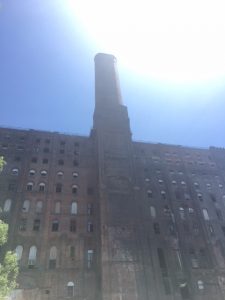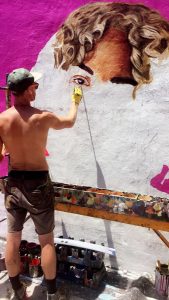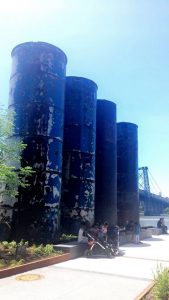Domino Park Field Trip Reflection
Donna Chow
HMGT 4987-HD91/ Urban Tourism
Professor Susan Phillip
6/14/2018

Photos taken in Domino Park, Williamsburg
One June 12th, 2017, our Urban Tourism class had the pleasure to take a tour around Domino Park in Williamsburg, Brooklyn. While we were walking there, as mentioned in class we saw the change in the waterfronts, of how old buildings are now residential buildings or offices. The idea of adaptive reuse, where older structures or spaces are recreated into something with a purpose, such as the waterfronts Dumbo and Domino Park. Professor Phillip mentioned while we were walking to Dumbo about the projects that are still around and how buildings with a clock provided people with the time (a service) as there were no watches back then, and the area was full of factories where people worked. While we walked to Fulton street there we noticed that it was a landmark area with all the brownstones, and old warehouses. Professor Philip pointed out the Eagle warehouse, which is now a residential building. There was also a block of old buildings, some in construction, some had restaurants on the first floor. I started seeing the waterfront when we walked even further down to Fulton Street. There were many people on trips, there were tourists and students taking class trip, like us. Then, we finally reached Dumbo where we went to buy our tickets ($2.75 for one-way trip) to take the NYC Ferry to Domino Park.
Our class entered the ferry around 12:30pm. I felt very excited because I love cruises. This

Photos taken in Domino Park, Williamsburg.
ferry looked fairly new and clean. The lower deck had many rows of chairs and there was also a mini-food bar. Then, the class walked up to the top deck where we could enjoy the view of the city a lot more clearly. The views off the ferry was phenomenal because then I could see the mixture of older and modern architecture. The mix of older warehouses and factories and newer residential buildings There’s a difference between then and now, the idea that the city is still progressing, and evolving is amazing. I could recognize that areas that had docks, used to be and industrial factory’s docks makes it so unimaginable and makes me want to see what this area looks like in the past. New York City was one of the most industrialized cities, where there were coffee bean factories, the sugar refinery factory, cardboard, and etc.
It is incredible how much Williamsburg and different parts of the city has changed from being something that was undesirable into something that will soon revitalize its popularity. Just the right example is this Domino Park, which used to be part of the Domino Sugar Refinery. Now it has been transformed into a park, a recreational space. As the ferry docked , first thing all of us probably noticed are the three gigantic luxurious rental apartment buildings, but Professor Phillips points out a good question… “Who is going to live in these?” Therefore, I was thinking, it must be expensive to live here, but I thought it was good to look at. I guess this was a good example of gentrification because later as we walked towards the park I started to notice the difference of how modern buildings change to older looking buildings. And I saw the problem as “who is going to benefit in this neighborhood?” (what type of social class). I started to reference back to the different documentaries our class watched, and I get a better understanding of how much the city has changed from being a poorer neighborhood, to now a neighborhood, which is unaffordable for the middle or lower classes.
My thoughts on Domino Parks itself. I thought the park was pretty friendly to anyone. The food options were limited, and hopefully they will recognize it sooner (they have just opened up on June 10). I thought it was uneasy for cars to get around because there is still construction going on. It is better to navigate by bike or foot. Professor Phillip mentions that there was a lack of signages as of pointing what was what in the park. For example, the four long tubes in the park or those two blue cranes. Also, there were portable bathrooms, but they were all not in service at the time. Other than that, I thought it was an eye-opening experience.









